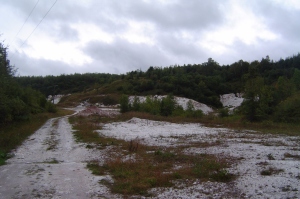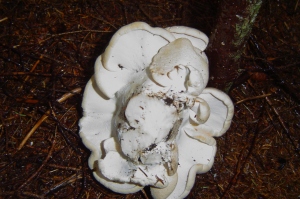Visiting a place which is new to me today, lots of caves in the area with plenty of limestone and gypsum outcrops. Should see some Chanterelle and some other interesting mushrooms.
Usually I do not see Suillus grevillei till next month though here they are.
Can’t see any larch trees here either though the larch is I believe Suillus grevillei’s only tree associate.
This one is a new Russula to me, very robust thick stem and compact heavy cap with a cap and stem color I haven’t noticed on Russulas before.
The deep black staining on the gills calls for further investigation. I sliced the mushroom down the center and it turned black within a few minutes. This mushroom must be Russula adusta or a very close relative. This is an inedible mushroom.
More yellow Coral mushrooms which I can’t identify as of yet. We have 3 different types of yellow coral in my area by the looks of things. I’ll have them figured out by next year.
Ah, I’ve seen some big Sweet tooth mushrooms lately but this is too much.
On flipping this one over I notice there is too much, as in tiny pores instead of long teeth. This mushroom is either Sheep Polypore or Albatrellus confluens both are edible and I haven’t tried either one yet.
More of this Albatrellus species mushrooms are on this hillside.
It is kind of interesting that in Europe Sheep Polypore (Albatrellus ovinus) is considered the best edible, while in North America Albatrellus confluens is viewed as the better edible mushroom as long as it is well cooked. Back in Europe Albatrellus confluens in most of the northern countries is parboiled and then cooked again when it is eaten though few eat it when Albatrellus ovinus is available.
I won’t know which Albatrellus I have here until I get some in the frying pan and heat it awhile as Albatrellus ovinus’ white flesh turns lemon yellow and Albatrellus confluens white flesh turns an apricot color when cooked. These mushrooms once cooked appear closer to the apricot shade so I suspect these are Albatrellus confluens.
Since this is my initial try with this mushroom I did take the European advise and parboiled and then fully cooked the mushrooms later in the frying pan, the aroma of the cooking mushrooms was pleasant and the taste was quite good though I only ate a small quantity to be on the safe side. Oh with all the new mushrooms grabbing my attention I didn’t show any of the nice Chanterelle I gathered out there, well sometimes it is interesting to show only the surprises. ciao












